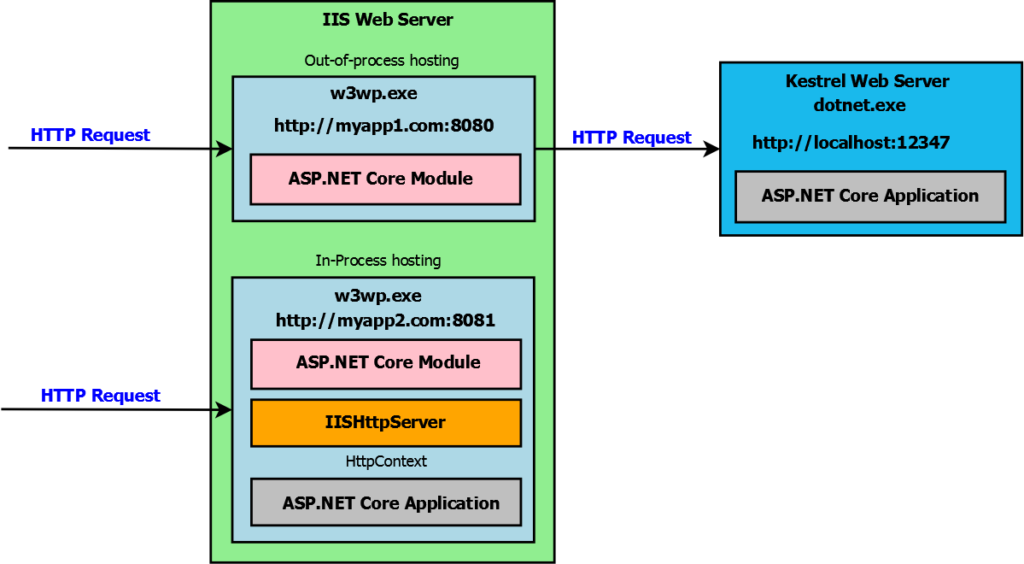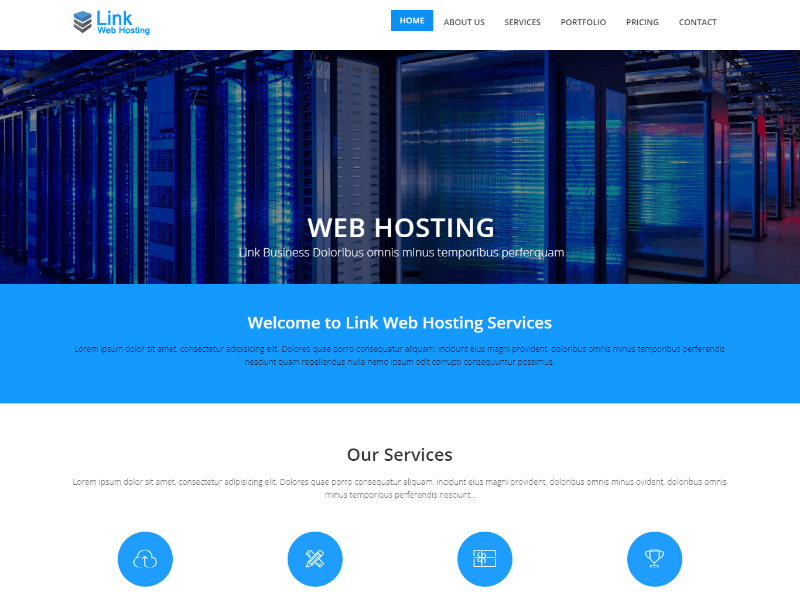Asp net core hosting – ASP.NET Core hosting is the foundation for deploying your web applications, offering a range of options to suit different needs. From the familiar IIS to the lightweight Kestrel server, ASP.NET Core empowers you to choose the hosting model that best aligns with your project’s requirements and desired level of control.
Understanding the various hosting models, their advantages and disadvantages, and how to configure your ASP.NET Core application for seamless deployment is crucial for achieving optimal performance, scalability, and security.
Understanding ASP.NET Core Hosting Options: Asp Net Core Hosting
ASP.NET Core offers flexibility in choosing how to host your web applications. Two primary options are IIS hosting and self-hosting with Kestrel. Each approach comes with its advantages and disadvantages, making the choice dependent on your specific needs and application requirements.
IIS Hosting
IIS hosting leverages the well-established Internet Information Services (IIS) web server, a mature and reliable platform widely used for hosting web applications on Windows. This approach integrates seamlessly with the Windows ecosystem and benefits from IIS’s extensive features and capabilities.
- Advantages:
- Mature and reliable platform: IIS has a long history and is known for its stability and reliability, providing a solid foundation for hosting web applications.
- Extensive features: IIS offers a comprehensive set of features, including request management, security features, and performance optimization tools.
- Integration with Windows ecosystem: IIS integrates seamlessly with other Windows components and tools, simplifying management and administration.
- Support for .NET Framework applications: IIS can also host traditional .NET Framework applications, providing a consistent platform for existing applications.
- Disadvantages:
- Windows-specific: IIS is a Windows-specific platform, limiting its use to Windows servers.
- Potentially complex configuration: IIS configuration can be complex, requiring familiarity with its settings and features.
Real-World Scenarios:
* Enterprise applications requiring high availability and stability: IIS’s maturity and reliability make it suitable for mission-critical applications requiring uptime and stability.
* Applications leveraging existing Windows infrastructure: If your organization already uses Windows servers and tools, IIS offers a familiar and integrated hosting environment.
* Applications requiring features like URL rewriting or authentication: IIS provides a rich set of features that can be leveraged for these purposes.
Self-hosting with Kestrel
Kestrel is a cross-platform web server specifically designed for ASP.NET Core. It’s a lightweight and high-performance server that provides a flexible and efficient hosting solution.
- Advantages:
- Cross-platform: Kestrel runs on Windows, macOS, and Linux, providing platform independence for your applications.
- Lightweight and high-performance: Kestrel is designed for efficiency and speed, making it ideal for performance-sensitive applications.
- Flexibility: Kestrel offers fine-grained control over its configuration and behavior, allowing for customization to meet specific needs.
- Disadvantages:
- Limited features compared to IIS: Kestrel lacks the extensive feature set of IIS, such as URL rewriting and authentication.
- Requires additional configuration: Self-hosting with Kestrel requires configuring additional components for tasks like reverse proxying and security.
Real-World Scenarios:
* Microservices and containerized applications: Kestrel’s lightweight nature and cross-platform support make it ideal for microservices and containerized deployments.
* Performance-critical applications: Kestrel’s efficiency and speed are valuable for applications demanding high performance.
* Applications requiring specific configurations or customization: Kestrel’s flexibility allows for tailored configurations to meet unique application requirements.
Managing ASP.NET Core Hosting Environments

ASP.NET Core applications can be deployed to different environments, such as development, staging, and production. Each environment may require different configurations and settings to function correctly. Managing these environments efficiently is crucial for smooth application development and deployment.
Environment Configuration in ASP.NET Core
ASP.NET Core uses a flexible configuration system to manage settings for different environments. This allows you to easily tailor your application’s behavior based on where it’s running.
The core concept is to use environment variables to distinguish between different environments. These variables can be set in your project’s configuration files (like *appsettings.json*) or directly within your hosting environment.
Here’s a breakdown of the common environments and their characteristics:
- Development: This environment is used for local development and debugging. It typically has relaxed security settings and logging levels, making it easier to identify and fix issues.
- Staging: This environment mirrors the production environment as closely as possible. It’s used for testing and validating the application before deploying to production.
- Production: This is the live environment where the application is accessible to users. It has stricter security measures and logging levels, prioritizing performance and stability.
Environment-Specific Configurations
You can use environment variables to configure different settings for each environment. For example:
- Database connection strings: You can define separate connection strings for development, staging, and production databases to ensure you’re connecting to the appropriate database.
- Logging levels: In development, you might want verbose logging to track issues easily. In production, you might want to limit logging to critical errors to avoid performance bottlenecks.
- Feature toggles: You can use environment variables to enable or disable certain features based on the environment. For instance, you might disable a new feature in staging to test it thoroughly before enabling it in production.
Example: Using Environment Variables
Let’s consider a simple example:
“`csharp
public class Startup
public Startup(IConfiguration configuration)
Configuration = configuration;
public IConfiguration Configuration get;
public void ConfigureServices(IServiceCollection services)
// Get the database connection string from configuration
var connectionString = Configuration.GetConnectionString(“DefaultConnection”);
// Configure logging level based on environment
var loggingLevel = Configuration.GetValue
// Configure other services based on environment
// …
// …
“`
In this example, we use the `IConfiguration` interface to access environment-specific values. You would define these values in your *appsettings.json* file, using the environment variable `ASPNETCORE_ENVIRONMENT` to differentiate settings:
“`json
“ConnectionStrings”:
“DefaultConnection”: “Server=(localdb)\\mssqllocaldb;Database=MyDatabase;Trusted_Connection=True;MultipleActiveResultSets=true”
,
“Logging”:
“LogLevel”:
“Default”: “Information”
“`
And in your *appsettings.Development.json*:
“`json
“ConnectionStrings”:
“DefaultConnection”: “Server=(localdb)\\mssqllocaldb;Database=MyDatabaseDev;Trusted_Connection=True;MultipleActiveResultSets=true”
,
“Logging”:
“LogLevel”:
“Default”: “Debug”
“`
This allows you to use different connection strings and logging levels for development and production environments.
Monitoring and Troubleshooting ASP.NET Core Applications
Monitoring and troubleshooting ASP.NET Core applications in production is essential for ensuring application stability and performance. It allows developers to identify and resolve issues quickly, minimizing downtime and improving the user experience.
Monitoring ASP.NET Core Applications
Monitoring provides insights into the health and performance of your ASP.NET Core application. It helps you track key metrics, detect anomalies, and identify potential problems before they impact users.
- Application Performance Monitoring (APM) Tools: APM tools offer comprehensive monitoring capabilities, providing insights into application performance, resource utilization, and code execution. These tools can track metrics like response times, error rates, and resource consumption. Popular APM tools include:
- New Relic
- Datadog
- Azure Application Insights
- Dynatrace
- Logging: ASP.NET Core provides a flexible logging system that allows you to capture information about application events, errors, and warnings. You can configure logging to different destinations, such as files, databases, or cloud services. Here are some logging frameworks for ASP.NET Core:
- Serilog
- NLog
- Microsoft.Extensions.Logging
- Metrics: ASP.NET Core allows you to expose application metrics, such as request counts, error rates, and resource usage. These metrics can be monitored using tools like Prometheus or Grafana. For example, you can configure ASP.NET Core to expose metrics through the Prometheus HTTP endpoint.
Troubleshooting Common Hosting Issues
Troubleshooting hosting issues involves identifying the root cause of problems and taking corrective actions. Common hosting issues include application crashes, performance degradation, and unexpected behavior.
- Application Crashes: Application crashes can be caused by various factors, including code errors, configuration issues, or resource limitations. To troubleshoot crashes, you can use logging, debugging tools, and error monitoring services.
- Examine Logs: Analyze application logs for error messages, stack traces, and other relevant information that can help pinpoint the cause of the crash. You can also use logging to track the state of your application before the crash occurred.
- Debugging Tools: Use debugging tools like Visual Studio or JetBrains Rider to step through the code, examine variables, and identify the source of the crash. These tools allow you to debug your application in real-time.
- Error Monitoring Services: Error monitoring services can automatically capture and report application crashes, providing insights into the frequency, severity, and impact of errors. Examples include:
- Sentry
- Rollbar
- Performance Problems: Performance issues can be caused by slow database queries, inefficient code, or resource bottlenecks. You can use profiling tools and performance monitoring to identify performance bottlenecks and optimize your application.
- Profiling Tools: Profiling tools can provide insights into code execution times, resource usage, and memory allocation. These tools can help you identify performance bottlenecks and optimize your code.
- Performance Monitoring: Performance monitoring tools can track key metrics, such as response times, CPU utilization, and memory usage. These tools can help you identify performance degradation and diagnose potential issues.
- Unexpected Behavior: Unexpected behavior can be caused by configuration issues, data corruption, or external factors. You can use logging, debugging tools, and monitoring to investigate and resolve these issues.
- Logging: Logging can provide valuable information about the state of your application and the events that led to the unexpected behavior.
- Debugging Tools: Debugging tools can help you step through the code and identify the source of the unexpected behavior.
- Monitoring: Monitoring can help you track application metrics and identify anomalies that may indicate unexpected behavior.
Using Logging and Debugging Tools for Troubleshooting, Asp net core hosting
Logging and debugging tools are essential for troubleshooting ASP.NET Core applications. These tools allow you to capture information about application events, errors, and warnings, and to examine code execution in real-time.
- Logging: ASP.NET Core provides a flexible logging system that allows you to capture information about application events, errors, and warnings. You can configure logging to different destinations, such as files, databases, or cloud services. You can also use logging to track the state of your application before a problem occurred.
- Log Levels: ASP.NET Core provides different log levels, such as Trace, Debug, Information, Warning, Error, and Critical. You can configure the logging level to control the amount of information captured. For example, you can set the logging level to Debug during development to capture detailed information about application events.
- Log Providers: ASP.NET Core supports various log providers, including file, console, and event log providers. You can configure logging to write logs to different destinations, such as files, databases, or cloud services. For example, you can configure logging to write logs to a file in production to track application events.
- Debugging Tools: Debugging tools like Visual Studio or JetBrains Rider allow you to step through code, examine variables, and identify the source of problems. These tools can be used to debug ASP.NET Core applications both locally and remotely.
- Breakpoints: Breakpoints allow you to pause code execution at specific points in your application. This allows you to examine the state of your application and identify the source of the problem.
- Watch Variables: Watch variables allow you to monitor the values of specific variables during code execution. This can help you identify issues related to variable assignments or calculations.
- Step Through Code: Stepping through code allows you to execute code line by line, examining the state of your application at each step. This can help you identify the source of the problem and understand the flow of execution.
Advanced ASP.NET Core Hosting Concepts
In the realm of ASP.NET Core hosting, exploring advanced concepts unlocks a new level of efficiency, scalability, and flexibility. This section delves into the world of Docker containers and cloud platforms, highlighting their benefits and providing practical examples for deploying ASP.NET Core applications.
Docker Containers for Hosting ASP.NET Core Applications
Docker containers offer a lightweight and portable way to package and run ASP.NET Core applications. They provide a consistent environment across different development and deployment environments, ensuring that applications behave as expected regardless of the underlying infrastructure.
Docker images are created based on a Dockerfile, which specifies the application’s dependencies, runtime environment, and configuration. This ensures that the application runs consistently, eliminating potential conflicts arising from different system configurations.
Here are the key benefits of using Docker for ASP.NET Core hosting:
- Portability: Docker containers are platform-independent, allowing applications to run seamlessly on various operating systems, including Windows, Linux, and macOS.
- Consistency: Docker ensures that the application runs in a consistent environment, regardless of the underlying infrastructure. This eliminates potential issues arising from different system configurations.
- Scalability: Docker containers can be easily scaled up or down based on demand, making it ideal for handling fluctuating traffic loads.
- Isolation: Each Docker container runs in its own isolated environment, preventing conflicts between applications and ensuring that resources are allocated efficiently.
“Docker is a powerful tool for packaging and running ASP.NET Core applications, providing a consistent and portable environment that simplifies deployment and enhances scalability.”
Cloud Platforms for Hosting ASP.NET Core Applications
Cloud platforms like Azure and AWS offer a range of services and features that simplify the deployment, management, and scaling of ASP.NET Core applications. These platforms provide infrastructure, resources, and tools that streamline the development and deployment process, allowing developers to focus on building applications.
- Infrastructure as a Service (IaaS): Cloud platforms like Azure and AWS offer virtual machines (VMs) that can be used to host ASP.NET Core applications. This approach provides more control over the underlying infrastructure but requires more management effort.
- Platform as a Service (PaaS): Platforms like Azure App Service and AWS Elastic Beanstalk provide a managed environment for deploying and scaling ASP.NET Core applications. This approach simplifies the deployment process and reduces the need for infrastructure management.
- Serverless Computing: Cloud platforms offer serverless computing services, such as Azure Functions and AWS Lambda, which allow developers to execute code without managing servers. This approach is ideal for event-driven applications and reduces the need for ongoing infrastructure management.
Configuring ASP.NET Core Applications for Cloud Deployment
Deploying ASP.NET Core applications to cloud platforms requires configuring the application to work within the platform’s environment. This typically involves setting up the application’s configuration, environment variables, and dependencies.
For example, when deploying an ASP.NET Core application to Azure App Service, you can configure the application’s settings using the Azure portal or the Azure CLI. You can also use environment variables to provide platform-specific configurations.
“Cloud platforms provide a comprehensive set of tools and services for deploying, managing, and scaling ASP.NET Core applications, enabling developers to focus on building applications while leveraging the platform’s infrastructure and capabilities.”
Conclusion
With a deep understanding of ASP.NET Core hosting, you can confidently deploy your applications, leveraging the flexibility and power of this framework to build robust and scalable web solutions. By exploring the different hosting models, configuration options, and security considerations, you’ll be well-equipped to manage your ASP.NET Core applications throughout their lifecycle.
ASP.NET Core hosting offers flexibility, allowing you to deploy your applications to various environments. If you’re looking for a robust and scalable cloud platform, consider AWS website hosting. AWS provides a range of services, including EC2 instances, Elastic Beanstalk, and Lambda functions, to accommodate different ASP.NET Core deployment strategies.




